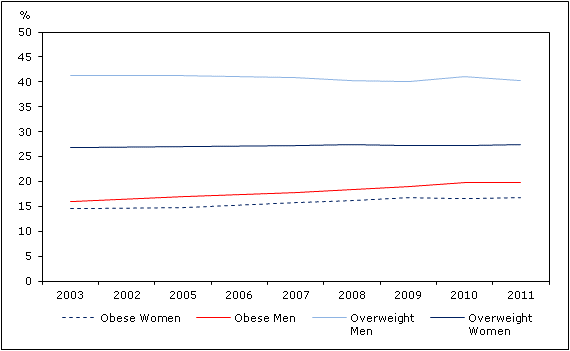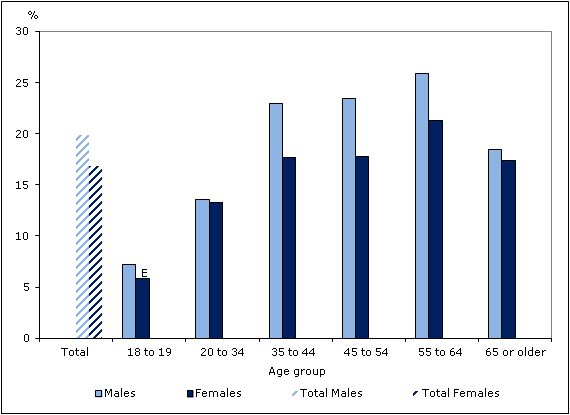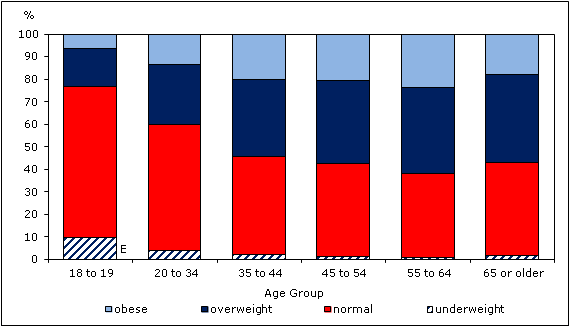Overweight and obese adults (self-reported), 2011
Archived Content
Information identified as archived is provided for reference, research or recordkeeping purposes. It is not subject to the Government of Canada Web Standards and has not been altered or updated since it was archived. Please "contact us" to request a format other than those available.

Obesity has been linked with many chronic diseases, including hypertension, type 2 diabetes, cardiovascular disease, osteoarthritis and certain types of cancer1.
To assess the health risks of obesity, the World Health Organization and Health Canada use guidelines based on Body Mass Index (BMI), a measure that examines weight in relation to height. BMI is defined as weight in kilograms divided by the square of the height in meters (Table 1). BMI is calculated for the population aged 18 and older, excluding pregnant women.
Table 1
Weight ranges for underweight, normal weight, overweight and obese for selected heights
| Height | Underweight* | Normal weight | Overweight* | Obese** |
|---|---|---|---|---|
| 5'4" | less than 107.5 lb | 107.6 to 145.2 lb | 145.3 to 174.3 lb | 174.4 lbs or more |
| 5'8" | less than 121.3 lb | 121.4 to 164.0 lb | 164.1 to 196.8 lb | 196.9 lbs or more |
| 6'0" | less than 136.0 lb | 136.1 to 183.8 lb | 183.9 to 220.6 lb | 220.7 lbs or more |
* increased risk of health problems
** high to extremely high risk of health problems
| Height | Underweight* | Normal weight | Overweight* | Obese** |
|---|---|---|---|---|
| 1.63 m | less than 48.8 kg | 48.9 to 66.0 kg | 66.1 to 79.2 kg | 79.3 kg or more |
| 1.73 m | less than 55.1 kg | 55.2 to 74.5 kg | 74.6 to 89.4 kg | 89.5 kg or more |
| 1.83 m | less than 61.8 kg | 61.9 to 83.5 kg | 83.6 to 100.2 kg | 100.3 kg or more |
* increased risk of health problems
** high to extremely high risk of health problems
BMI can be used to compare body weight patterns and related health risks within and between populations, and to establish population trends. For an individual, this measure should be used with caution because the health risks associated with each BMI category vary considerably between individuals. Particular caution is warranted when classifying adults who are naturally very lean or very muscular, as well as some ethnic and racial groups, and seniors.
The results shown here are based on height and weight as reported by survey respondents. Comparisons of self-reported height and weight with actual measurements have shown that women are inclined to underestimate their weight, while men tend to overestimate their height. Moreover, under-reporting of weight increases proportionately with BMI (see "Estimates of obesity based on self-report versus direct measures" in Health Reports). The report found that the obesity rate was 7.4 percentage points higher and the overweight rate was 1.9 percentage points higher when based on measured height and weight rather than self-reported data.
In 2011, 18.3% of Canadians aged 18 and older, roughly 4.6 million adults, reported height and weight that classified them as obese, virtually unchanged from 2009. However, from 2003 to 2011, obesity among men rose from 16.0% to 19.8%, and among women, from 14.5% to 16.8% (Chart 1).
When those who were overweight were included, 60.1% (7.6 million) of Canadian men and 44.2% (5.6 million) of women had an increased health risk because of excess weight. The rates of overweight and obese females and males have remained stable since 2009.
The overweight rates have been stable from 2003 to 2011 (Chart 1).
Chart 1
Percentage who were obese and overweight (self-reported), by sex, household population aged 18 or older, Canada, 2003 to 2011

Source: Canadian Community Health Survey, 2003, 2005, 2007, 2008, 2009, 2010, 2011.
The proportion of residents who were obese was lower than the national average in Quebec (16.9%) and British Columbia (15.1%). In Newfoundland and Labrador, Prince Edward Island, Nova Scotia, New Brunswick, Manitoba, Saskatchewan, and Northwest Territories obesity rates were significantly above the national average. In all other provinces and territories, the obesity rate was about the same as the national level.
In the age groups from 35 to 64, significantly more men than women were obese. Among both sexes, those aged 18 to 19 had the lowest obesity rate (Chart 2).
Chart 2
Percentage who were obese (self-reported), by age group and sex, household population aged
18 or older, Canada 2011

Note:
E Use with caution (coefficient of variation 16.6% to 33.3%).
Source: Canadian Community Health Survey, 2011.
In successively older age groups from 18 to 64, the percentage in the combined overweight-obese category increased significantly, while the percentage of Canadians underweight declined significantly (Chart 3).
Chart 3
Percentage who were underweight, normal weight, overweight and obese (self-reported), by age group, household population 18 or older, Canada, 2011

Note:
E Use with caution (coefficient of variation 16.6% to 33.3%).
Source: Canadian Community Health Survey, 2011
End note
- Tjepkema, Michael. 2006. "Adult Obesity." Health Reports. Vol. 17, no. 3. August. Statistics Canada Catalogue no. 82-003. page 9. /studies-etudes/82-003/archive/2006/9276-eng.pdf (accessed May 10, 2010).
References
Connor Gorber, Sarah, Margot Shields, Mark S.Tremblay and Ian McDowell. 2008. "The feasibility of establishing correction factors to adjust self–reported estimates of obesity." Health Reports. Vol. 19, no. 3. September. Statistics Canada Catalogue no. 82-003. /bsolc/olc-cel/olc-cel?lang=eng&catno=82-003-X200800310680 (accessed May 10, 2010).
Garriguet, Didier. 2008. "Obesity and the eating habits of the Aboriginal population." Health Reports. Vol. 19, no. 1. March. Statistics Canada Catalogue no. 82-003. /bsolc/olc-cel/olc-cel?lang=eng&catno=82-003-X200800110487 (accessed May 10, 2010).
Le Petit, Christel and Jean–Marie Berthelot. 2006. "Obesity—a growing issue." Health Reports. Vol. 17, no. 3. June. Statistics Canada Catalogue no. 82-003. pages 43–50. /studies-etudes/82-003/archive/2006/9278-eng.pdf (accessed May 10, 2010).
Orpana, Heather M., Mark S.Tremblay and Philippe Finès. 2007. "Trends in weight change among Canadian adults." Health Reports. Vol. 18, no. 2. May. Statistics Canada Catalogue no. 82-003. /bsolc/olc-cel/olc-cel?lang=eng&catno=82-003-X20060059633 (accessed May 10, 2010).
Shields, Margot, Sarah Connor Gorber and Mark S Tremblay. 2008. "Estimates of obesity based on self–report versus direct measures." Health Reports. Vol. 19, no. 2. June. Statistics Canada Catalogue no. 82-003. /bsolc/olc-cel/olc-cel?lang=eng&catno=82-003-X200800210569 (accessed May 10, 2010).
Shields, Margot, Sarah Connor Gorber and Mark S. Tremblay. 2008. "Effects of measurement on obesity and morbidity." Health Reports. Vol. 19, no. 2. June. Statistics Canada Catalogue no. 82-003. /pub/82-003-x/2008002/article/10564-eng.pdf (accessed May 10, 2010).
Shields, Margot and Mark S. Tremblay. 2008. "Screen time among Canadian adults: A profile." Health Reports. Vol. 19, no. 2. June. Statistics Canada Catalogue no. 82-003. /bsolc/olc-cel/olc-cel?lang=eng&catno=82-003-X200800210600 (accessed May 10, 2010).
Shields, Margot and Mark S. Tremblay. 2008. "Sedentary behaviour and obesity among Canadian adults." Health Reports. Vol. 19, no. 2. June. Statistics Canada Catalogue no. 82-003. /bsolc/olc-cel/olc-cel?lang=eng&catno=82-003-X200800210599 (accessed May 10, 2010).
Shields, Margot. 2006. "Overweight and obesity among children and youth." Health Reports. Vol. 17, no. 3. August. Statistics Canada Catalogue no. 82-003. pages 27–42. /studies-etudes/82-003/archive/2006/9277-eng.pdf (accessed May 10, 2010).
Shields, Margot and Michael Tjepkema. 2006. "Trends in adult obesity." Health Reports. Vol. 17, no. 3. August. Statistics Canada Catalogue no. 82-003. pages 53–59. /studies-etudes/82-003/archive/2006/9279-eng.pdf (accessed May 10, 2010).
Shields, Margot and Michael Tjepkema. 2006. "Regional differences in obesity." Health Reports. Vol. 17, no. 3. August. Statistics Canada Catalogue no. 82-003. pages 61–67. /studies-etudes/82-003/archive/2006/9280-eng.pdf (accessed May 10, 2010).
Tjepkema, Michael. 2006. "Adult Obesity." Health Reports. Vol. 17, no. 3. August. Statistics Canada Catalogue no. 82-003. pages. 9–24. /studies-etudes/82-003/archive/2006/9276-eng.pdf (accessed May 10, 2010).
Tremblay, Mark S., Claudio E. Pérez, Chris I. Ardern, Shirley N. Bryan and Peter T. Katzmarzyk. 2005. "Obesity, overweight and ethnicity." Health Reports. Vol. 16, no. 4. June. Statistics Canada Catalogue no. 82-003. pages 23–34. /studies-etudes/82-003/archive/2005/8041-eng.pdf (accessed May 10, 2010).
Wilkins, Kathryn and Margaret de Groh. 2005. "Body mass and dependency." Health Reports. Vol. 17, no. 1. November. Statistics Canada Catalogue no. 82-003. pages 27–39. /studies-etudes/82-003/archive/2005/8708-eng.pdf (accessed May 10, 2010).
Data
Additional data from the Canadian Community Health Survey are available from CANSIM table 105–0501.
- Date modified:
